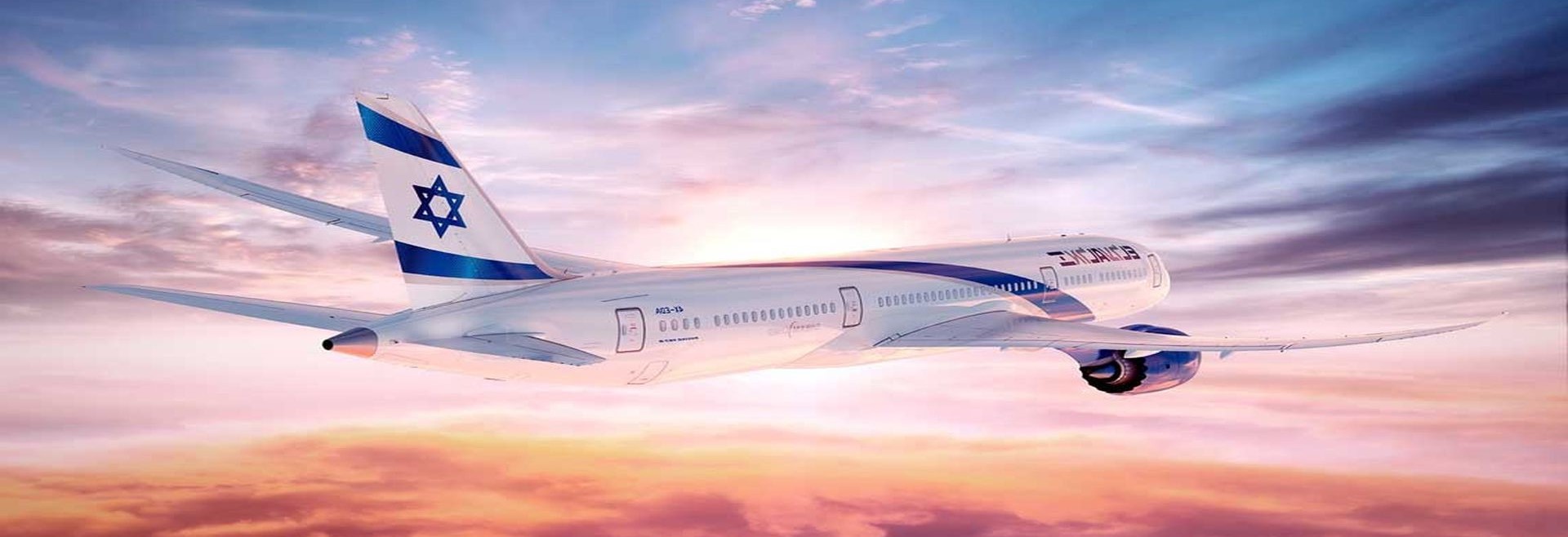
Rabbi Glickman’s Trip to Israel
From Israel to Calgary: Report and Discussion with Rabbi Glickman about his recent trip to Israel
Monday, November 20 at 7:00 pm | View ZOOM recording
UPDATES:
Update #1 (Pre-Trip): The Preparations Begin
My visit to Israel is about to draw to a close.
This morning, we began in Tel Aviv, with a briefing from a high-ranking IDF official. He described some of the challenges – military ones and others – that Israel is facing in this chaotic and scary time of war.
From there, we went to Shura, an army base near Ramle. This is where the bodies of terror victims and fallen soldiers are taken for identification. We saw racks of stretchers that had been used for the deluge of bodies that had recently come into the facility. We saw large refrigeration units where the bodies were stored. We entered a room – one of many – where the families of fallen soldiers can spend time with the bodies of their loved ones. We learned that, while other Western countries try to notify the families of fallen soldiers within an hour after the bodies are identified, Israel tries to do it within fifteen minutes. Israel is a small country, they reminded us, and the IDF wants to be sure that families learn the tragic news of their loved ones’ deaths from the IDF itself rather than through social media. They describe it as “the race against WhatsApp.”

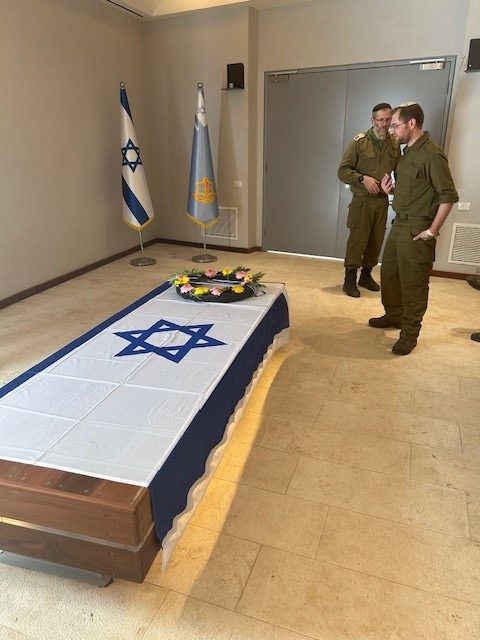
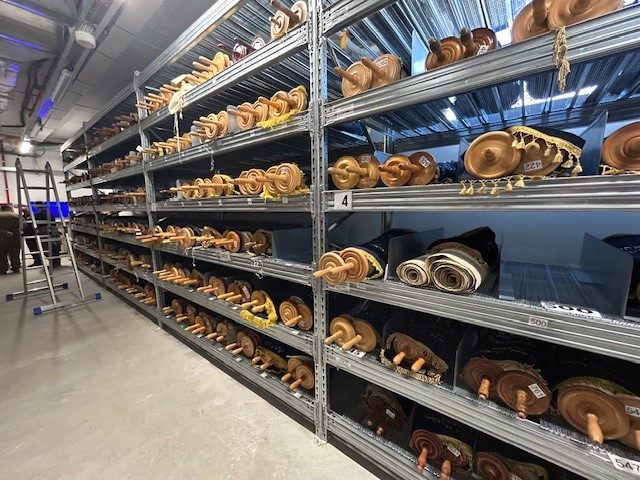
Shura is also the headquarters of the IDF’s rabbinate. One of its chaplains showed us a large warehouse and processing center for Torah scrolls, donated from around the world for use in Israel’s army bases. We heard stories of how, on October 7, the terrorists knew ahead of time where the synagogues were located in the communities they attacked, and how they targeted those synagogues – not only to find people there but also to get their hands on Jewish sacred items. We saw state-of-the-art talitot katan – fringed undergarments (quick-drying ones) that even most secular soldiers are choosing to wear under their uniforms these days.
I’ve said in previous emails that I’ll save my reflections on this experience for my Zoom session with you on Monday, November 20, at 7:00 PM. I will, however, share one thought here.
Seeing the way Israel has had to deal with the massive number of deaths it experienced after the attacks gave me a sense, I think, of what Allied soldiers must have experienced when they liberated the death camps of Nazi Europe. I didn’t see any dead bodies, of course, and the number of deaths here in Israel was far less than the number of those killed during the Holocaust, but still….
And then, on the way back to Jerusalem from Shura, we got caught in a traffic jam. That’s because, for the most part, Israelis are still going to work each morning, and they’re still shopping, and their kids are going to school. Life goes on here, even in the face of tragedy.
Israel these days, in other words, is the land of death and traffic jams. That is the terrible, inspirational, bewildering reality of this magnificent country today.
In a few hours, I board a plane to head home to Calgary… and I look forward to seeing you very, very much.
Shalom,
Rabbi Mark Glickman
Shalom Everyone,
Having been in Israel for a few days now, I am finding my experience here to be horrible, comforting, and inspirational all in equal measure. As I mentioned in previous emails, please join me on Zoom, at 7:00 PM, Monday, November 20 for a full report and reflections.
Our day began with a visit to Natal, an organization providing various kinds of trauma therapy to people throughout Israel. We heard about the amazing work they are doing in response to the recent violence.
From there, we went to Shefayim, a kibbutz and resort hotel North of Tel Aviv. After October 7, this kibbutz took in hundreds of evacuees from Kfar Azza, another kibbutz near the Gaza Strip that suffered horribly from the Hamas attacks. The evacuees still remain at Shefayim, and we met with several of them today. In vivid detail, they shared stories of what they experienced on that horrible day. Hearing what they endured brought tears to our eyes; hearing their commitment to rebuilding their lives and their community was nothing short of inspirational.
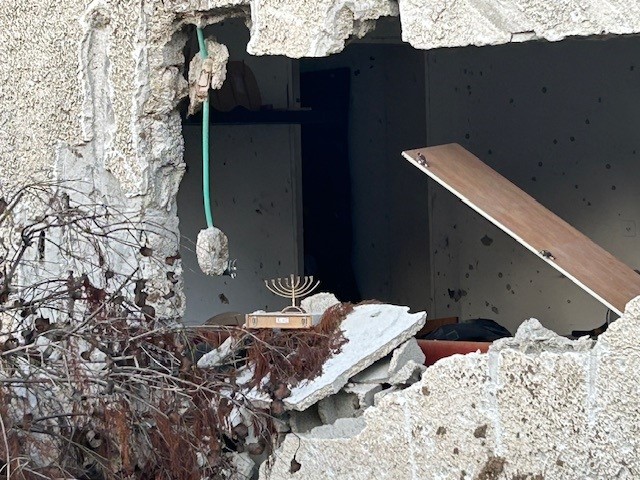
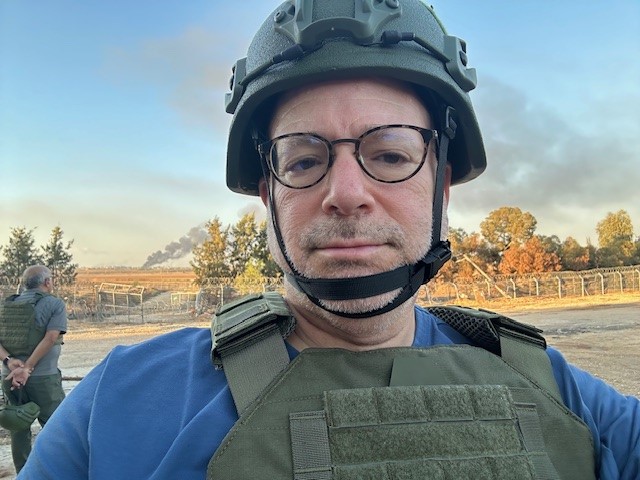
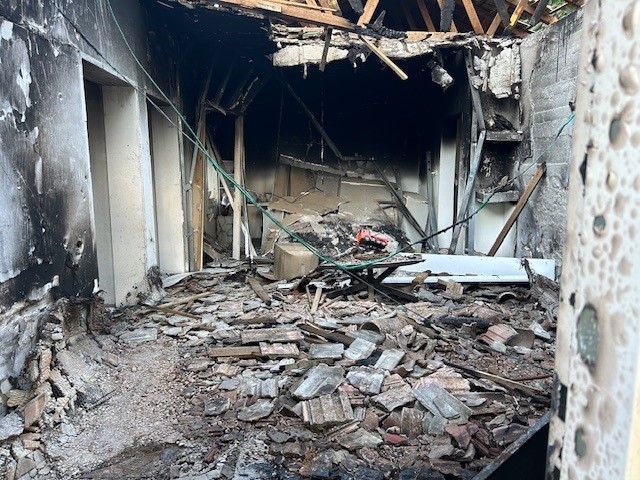
Then, we drove south to Kfar Azza itself. Before arriving, we stopped at another nearby kibbutz, Sa’ad, where we met IDF liaisons who outfitted us with helmets and flak jackets.
And then we went to Kfar Azza. It was utterly horrific. I’ll share the details on Monday about what we saw. Here, suffice it to say that, of Kfar Azza’s 960 residents, 62 were killed on October 7, and 18 were kidnapped (of whom seven were children). We saw their destroyed homes; we went into the safe rooms where they cowered for days as the terrorists rampaged through their community; we met with more survivors. And through it all, we heard deafening booms of outgoing mortars and saw smoke rising above Gaza City in the distance.
The day ended more joyfully, as we went to a small army base called Magen Alumim, where 150 or so soldiers are stationed. We schmoozed with them, they told us their stories, and we had the opportunity to treat them to a wonderful barbecue dinner. They were so grateful. We ended the evening by putting our arms around their shoulders to share a prayer and a rousing chorus of Hatikvah. At that moment, at least for me, the tears flowed once again.
Tomorrow is my final day in Israel, and I’ll try to get another update to you before my plane leaves late at night. For now, I’ll just conclude by saying that ALL of the Israelis we’ve met seem genuinely grateful that we are here – soldiers, survivors, care workers, and all the rest. It’s been an honor to spend time with them and to share wishes for comfort and strength on my behalf, and on your behalf, too.
Shalom,
Rabbi Mark Glickman
I am just concluding the first day of my trip here – a solidarity mission to Israel with Reform and Conservative rabbis from North America – and the experience has also been both emotionally overwhelming and powerfully inspirational. I’m still processing much of it, and I’ll save my Big Thoughts for a Zoom report and discussion next Monday night at 7:00 PM. Please save the date, and watch your email for details. Here, as I still try to make sense of it, I’ll just share a few highlights.
My plane arrived late last night. Walking through the airport took me past a long hallway lined for a hundred meters or so with pictures of the hostages…old people, young adults, children… one picture every few feet it was deeply moving.
Little did I know what I would encounter today.
This morning, I traveled back to the airport to meet the rest of my group and our guide. Our first stop was at Brothers for Life (Achim L’chayim), an organization that supports wounded Israeli soldiers, ensuring that they receive needed medical care, attending to their mental health needs, and giving them a nice place to simply hang out with one another. We met some of the soldiers and learned about this organization’s important work.
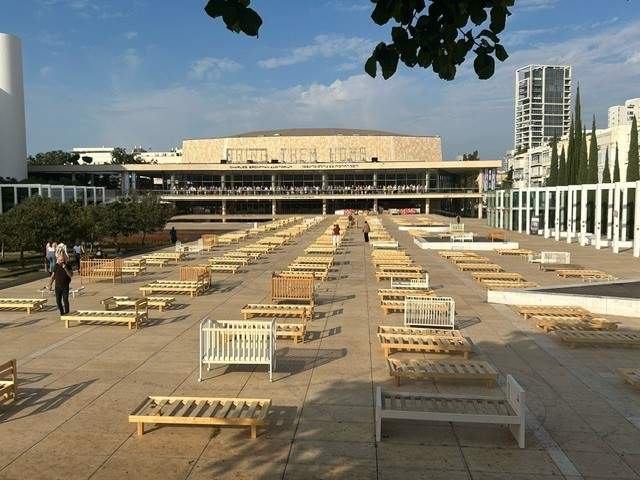
From there, we went to Tel Aviv, where the plaza outside the Bronfman Cultural Center was filled with 239 empty beds – some of them cribs – one for each hostage.
Empty beds.
From there, proceeded to a nondescript office building, went up to the sixth floor, and entered a facility the likes of which I never would have imagined even existed. This was the headquarters of the Hostages and Missing Families Forum. It looked like a cramped “Mission Control Center,” busy with cubicles, folding tables, and computer screens, littered with pizza boxes and empty coffee cups. This is where the families of the hostages and their representatives do their work. 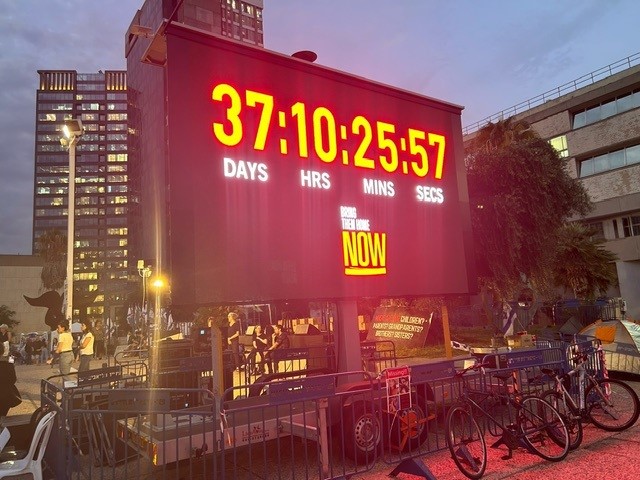 They connect hostage families with government officials and resources, they conduct press conferences, they convene groups of foreign dignitaries, and, whenever possible, they negotiate on behalf of the hostages. There, our group met with several former Israeli ambassadors who are working on behalf of the hostages, and we also heard from several of the family members themselves, who told us their heartrending stories.
They connect hostage families with government officials and resources, they conduct press conferences, they convene groups of foreign dignitaries, and, whenever possible, they negotiate on behalf of the hostages. There, our group met with several former Israeli ambassadors who are working on behalf of the hostages, and we also heard from several of the family members themselves, who told us their heartrending stories.
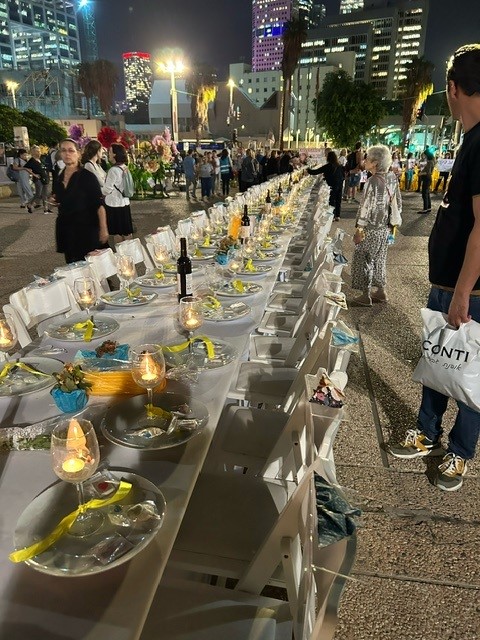
Then it was on to Kikar HaChatufim – Hostages Square. Until a few weeks ago, this was simply the plaza outside the Tel Aviv Museum, but now it is filled with moving displays of all kinds – a Shabbat table with a place set for each hostage, beautiful sculptures and other artistic creations, and people too numerable to count walking around holding pictures of their kidnapped loved ones. Our group participated in a prayer service as we joined in expressing our fervent hope that the hostages return home soon.
Over a late dinner, we heard from a man whose sister and brother-in-law had been taken captive, and we also had a conversation with Alon Tal, an American-born member of the Knesset who shared some of his perspectives regarding these recent events.
All day long, everyone we met told us how very much they appreciate our being here, and how important it is to them that we tell the world about what is happening on the ground here. I plan to do everything I can to do just that.
Tomorrow includes more briefings and visits – please stay tuned for updates.
Shalom,
Rabbi Mark Glickman
I am just concluding the first day of my trip here – a solidarity mission to Israel with Reform and Conservative rabbis from North America – and the experience has also been both emotionally overwhelming and powerfully inspirational. I’m still processing much of it, and I’ll save my Big Thoughts for a Zoom report and discussion next Monday night at 7:00 PM. Please save the date, and watch your email for details. Here, as I still try to make sense of it, I’ll just share a few highlights.
My plane arrived late last night. Walking through the airport took me past a long hallway lined for a hundred meters or so with pictures of the hostages…old people, young adults, children… one picture every few feet it was deeply moving.
Little did I know what I would encounter today.
This morning, I traveled back to the airport to meet the rest of my group and our guide. Our first stop was at Brothers for Life (Achim L’chayim), an organization that supports wounded Israeli soldiers, ensuring that they receive needed medical care, attending to their mental health needs, and giving them a nice place to simply hang out with one another. We met some of the soldiers and learned about this organization’s important work.
 From there, we went to Tel Aviv, where the plaza outside the Bronfman Cultural Center was filled with 239 empty beds – some of them cribs – one for each hostage.
From there, we went to Tel Aviv, where the plaza outside the Bronfman Cultural Center was filled with 239 empty beds – some of them cribs – one for each hostage.
Empty beds.
From there, proceeded to a nondescript office building, went up to the sixth floor, and entered a facility the likes of which I never would have imagined even existed. This was the headquarters of the Hostages and Missing Families Forum. It looked like a cramped “Mission Control Center,” busy with cubicles, folding tables, and computer screens, littered with pizza boxes and empty coffee cups. This is where the families of the hostages and their representatives do their work.  They connect hostage families with government officials and resources, they conduct press conferences, they convene groups of foreign dignitaries, and, whenever possible, they negotiate on behalf of the hostages. There, our group met with several former Israeli ambassadors who are working on behalf of the hostages, and we also heard from several of the family members themselves, who told us their heartrending stories.
They connect hostage families with government officials and resources, they conduct press conferences, they convene groups of foreign dignitaries, and, whenever possible, they negotiate on behalf of the hostages. There, our group met with several former Israeli ambassadors who are working on behalf of the hostages, and we also heard from several of the family members themselves, who told us their heartrending stories.
 Then it was on to Kikar HaChatufim – Hostages Square. Until a few weeks ago, this was simply the plaza outside the Tel Aviv Museum, but now it is filled with moving displays of all kinds – a Shabbat table with a place set for each hostage, beautiful sculptures and other artistic creations, and people too numerable to count walking around holding pictures of their kidnapped loved ones. Our group participated in a prayer service as we joined in expressing our fervent hope that the hostages return home soon.
Then it was on to Kikar HaChatufim – Hostages Square. Until a few weeks ago, this was simply the plaza outside the Tel Aviv Museum, but now it is filled with moving displays of all kinds – a Shabbat table with a place set for each hostage, beautiful sculptures and other artistic creations, and people too numerable to count walking around holding pictures of their kidnapped loved ones. Our group participated in a prayer service as we joined in expressing our fervent hope that the hostages return home soon.
Over a late dinner, we heard from a man whose sister and brother-in-law had been taken captive, and we also had a conversation with Alon Tal, an American-born member of the Knesset who shared some of his perspectives regarding these recent events.
All day long, everyone we met told us how very much they appreciate our being here, and how important it is to them that we tell the world about what is happening on the ground here. I plan to do everything I can to do just that.
Tomorrow includes more briefings and visits – please stay tuned for updates.
Shalom,
Rabbi Mark Glickman
One of the things I’ve learned lately is that Israel is a very difficult place to get to these days. Preparing for my upcoming trip, I’ve now had four flights canceled, and for several hours the other day and today, I thought I was going to have to cancel my trip completely. Fortunately, I was able to book another itinerary, so the trip is back on. I now plan to leave on Saturday rather than Friday as I had originally planned. Flying through London and Cyprus, I arrive in Israel late Sunday night. Things can change at any moment, though, and I won’t know for sure that I’m actually going to Israel until I get there.
But I’m trying to stay optimistic. My travel group will consist of fifteen Reform and Conservative rabbis, and our itinerary continues to develop. For security reasons, we’ve been asked not to divulge the details of that itinerary, but I can share some general information. On the first day alone, we will have a visit with wounded soldiers, another with trauma intervention professionals, and yet another with hostages’ families. The remaining days in Israel will include an excursion to communities directly attacked on October 7, meetings with leading journalists and officials, opportunities to volunteer and give blood, time with displaced Israeli families, hospital visits, and much more.
As I mentioned in my original email, my top priority in taking this trip is to bring whatever small measure of comfort I can to our Israeli brothers and sisters. Along the way, however, I hope to learn and gain insights, as well. Among the questions on my mind are:
- What kind of support do Israelis need most from us here in the Diaspora? Moral support? Money? Political advocacy? Anything else? What specific steps can we take that will be most helpful to them?
- How are Israelis thinking about the humanitarian dimension of the war? Does the suffering of Gazan civilians resonate in Israel in the same way it does for us here in Canada?
- What feelings are most prevalent in Israel now? Sadness? Anger? A desire for vengeance? Determination and resolve? I expect to find a combination of all those feelings and more, of course, but I’m eager to get a sense of it firsthand.
- In what ways, if any, do Israelis see the October 7 attacks as connected to Israel’s political upheaval and the judicial reform controversy of the past year or so?
- The Zionist dream has always envisioned Israel as a place where Jews could live in peace and safety. What is the status of the Zionist dream in Israel today?
- And to ask a question that is both vital and admittedly absurd in the face of the current situation: What of peace? Can we even envision a path to peace between Israel and its neighbors? If so, what might that path be?
Are there other Israel-related questions on your mind these days? If so, please let me know. I’d be glad to share whatever perspectives I might already have, and to keep your questions in mind during my visit next week.
On another topic, these are scary times not only in Israel but also for us here in Calgary. We watch with deep concern as we see outbreaks of antisemitism and other types of hatred throughout the world, and there have even been minor such incidents here in Calgary (that is, if any act of hate can be called “minor”). In response…
- Please know that, as your rabbi, I am working hard to build interfaith bridges at this time, particularly with the Muslim community. It’s difficult work during this time of conflict, but it continues, and I hope to it will bear some tangible fruit soon. Details coming.
- As frightening as these times are, let’s remember what a blessing it is to be Jewish. We are members of a wonderful community; we are inheritors of a sacred tradition; we are called to be a beacon of goodness and humanity in a world that desperately needs it. Amid the conflict we see around us, let’s proudly remain on that sacred path. Reach out to your Jewish friends – they need you. Reach out to your Muslim neighbors – they are hurting, too. Please don’t hide the Magen David around your neck – wear it proudly. Don’t take down your mezuzah – dust it off. Let’s show the world that being Jewish can embody being human at its finest. Only then can we each play our own small role in bringing light to the darkness.
And if you’d like to talk, I’m here until Saturday, then back again late next Friday. Please reach out whenever you’d like.
Shalom,
Rabbi Mark Glickman
